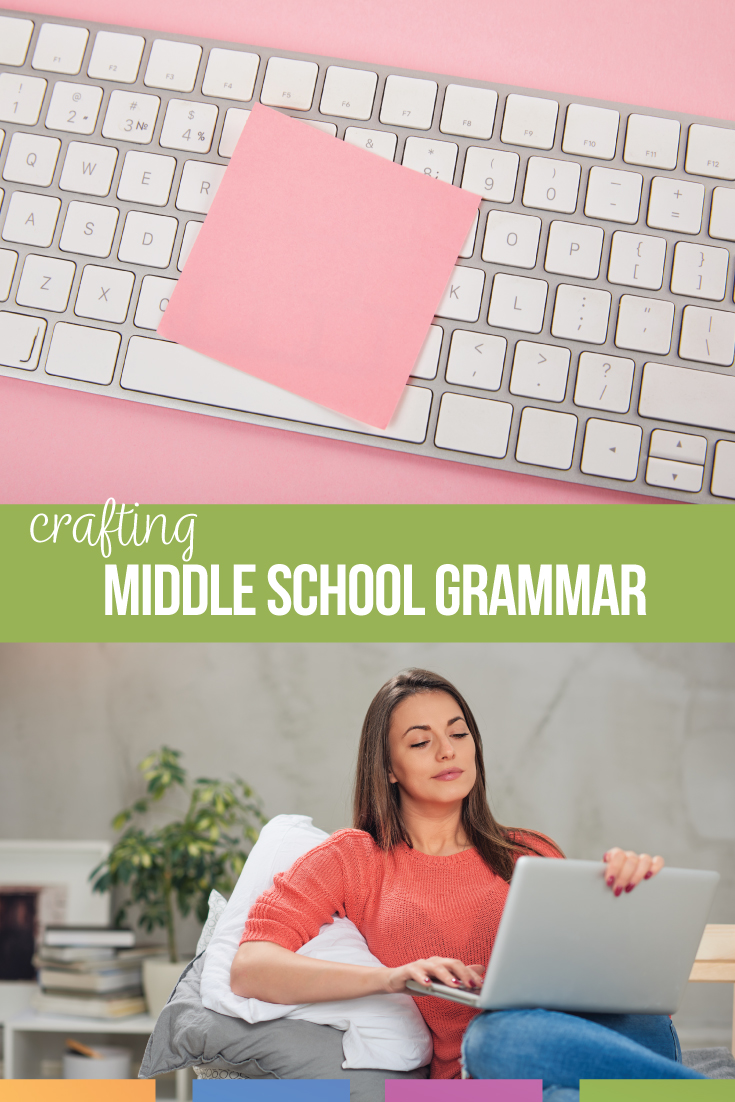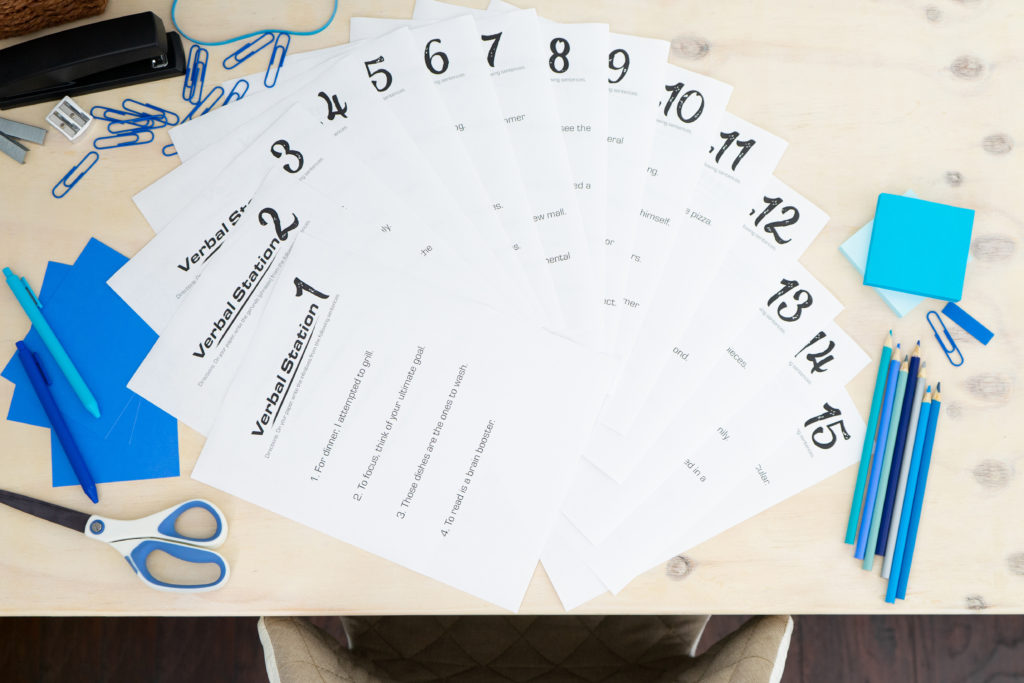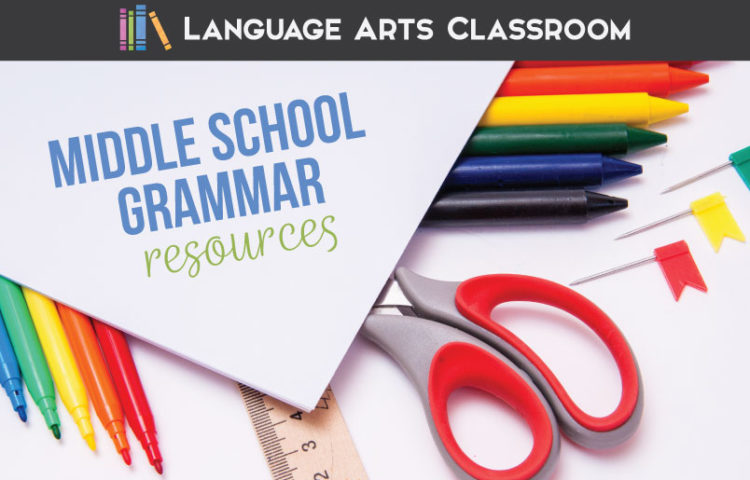Middle school grammar resources require a dash of fun and lots of engaging ideas to reach students. Embrace fun grammar activities middle school -style.
This post aims to help teachers use middle school grammar resources in engaging ways. When I begin planning grammar lessons, I consider best practices just like any other lesson. Some students don’t mind worksheets, but others will need hands-on activities, color, group work, and stations.
When I wrote my first grammar book years ago, I tried to incorporate direct instruction as well as opportunities for connections to other parts of class. No grammar lesson should only be identification! Students should explore their language in their writing and in other connections to their lives.
However, some memorization of terms and lists is necessary for grammar for middle school. If you look at standards in high school, you’ll see that students will need that strong foundation of domain-specific vocabulary to meet those difficult standards.
Additionally, students can appreciate grammar, and grammar can be the foundation for helping with reading comprehension. Many students enjoy grammar, often students who might not like other parts of an English course. As you continue to grow in your grammar instruction, you’ll experience the depth language studies can bring to all components of your class.
Below, you’ll find my best tips for building powerful grammar lessons with middle school students.

Basic grammar: start small
All of the higher standards concerning grammar rely on a basic knowledge. (Don’t they all?) Studying and memorizing can be boring and unfortunately, middle school is the time when students learn a chunk of grammar. Therefore when creating middle school grammar resources, clarity is important. But, what are simple approaches?
First, explain to students why they are practicing basic concepts like parts of a sentence. Students may not enjoy learning definitions and sentence components, but sometimes students are more involved if they understand the application for their futures.
Second, make practice interactive. Prepositions show location, and most of them can be in relation to a box. Grab a box from school, and print out these preposition cards. (The prepositions are a free download.) Ask students to show location on the box with the prepositions. As another activity with the cards, glue the preposition cards that won’t work on the box (except, regarding) and have students write silly prepositional phrases.
After students show understanding with key concepts of grammar, advance with more tools and more grammar activities.
Basic grammar: advance
Grammar worksheets can cover the basics, but when you move to task cards, coloring sheets, and digital activities, students retain information more. When I taught sixth grade, I made sure that grammar lessons were not always a worksheet. By doing so, I reached students who might not have a natural inclination toward grammar.
(I built similar activities for seventh grade grammar and eighth grade grammar as well.) The more middle school grammar you teach, the more tricks you’ll develop for hands-on learning.
Third, students remember the basics of grammar when they have fun. When you cover the eight parts of speech, for instance, you might want to make a pizza. Students decide what parts of speech make sense for a pizza topping (adverbs = peppers, spicy) and interact with the definitions. If you choose interactive notebooks, students will have the material in their possession. But! I also use interactive pieces as visuals for the classroom without a notebook.
Experiment with interactive notebook pieces on construction paper or poster boards. For instance, most teachers do not have extra time for building bulletin boards. Use interactive notebook pieces to showcase grammar lessons. Student-generated decor is meaningful to students.
Fourth, use a variety of activities. I use physical and digital grammar tools. Some students prefer the digital work and other times, students would rather hold the material. When students have choice, they take ownership. Plus, I can target practice to students. Some students need to work on phrases, others on punctuation, and others on sentence structure. When I use a variety of activities, students aren’t bored because the work is specific to their needs.
Basic grammar: review
So! You started small with grammar basics and advanced with engaging activities. Be sure to review and close with the importance of these lessons.
Finally, posters and anchor charts are great additions to the classroom, and they also provide quick chances for review. As students walk into the classroom, hand students a sticky note. Instruct them to write an example of a part of speech (for example) and add it under the poster. Then go on a gallery walk and discuss the goofy answers.
As students understand the basics of grammar (lists and definitions), you are probably ready to move into higher thinking skills.
Discovering grammar in context
When students understand the basics of a grammar concept, ask students to find it in context. Prewritten paragraphs and sentences work well, as do student created writing. Print out student paragraphs, and ask students to find certain components in their peers’ writing.
Another option is to have students work together. My favorite activity is grammar stations because students can work together, and I can circulate and help. Often, I will highlight sentences from the literature we are covering. Students can discover that grammar concepts apply to their reading material. As a bonus, you’ll be reviewing the stories too.
Don’t just have students find grammar in sentences and paragraphs! Have important discussions about the choices made in using particular language. Discuss why authors use certain sentence structure or certain verbs. In this way, grammar in context works well with vocabulary lessons.
Additionally, you can supply reminders at each station. If you need an example, download this list of comma rules for free:

Application of grammar
Once students grasp a concept, show students how to manipulate it in real life. Use their own writing or invent a sentence of your own to correct or improve the message. Explain how grammar is an important writing tool. For instance, when students write, take a sentence from each assignment and compile the sentences on a Google Slide. Comb through the sentences together as a class, bettering and moving the pieces of the sentences. (Sometimes I display this presentation, and other times I “make a copy for each student.”)
Second, use fun images and memorization tricks. I use “zombies” with active and passive voice. I ask students to add “by zombies” to the end of sentences to check for active or passive voice. You can do this with any sentence, and it will probably become a classroom joke. (You can also see my zombie grammar.) Trust me, the more you work with middle school grammar, the more inside jokes you’ll develop with your students.
Third, use everyday conversations and reading material to study grammar. Many textbooks have accompanying language studies. Use them. Acknowledge the parts of speech of vocabulary words. For example, identify pronouns as you speak, and then ask students to name their antecedents. Incorporating grammar terminology shows students that grammar is a natural part of life, that they already know grammar.
Experiment with these ideas for middle school resources. For teachers without a love of grammar, developing resources can take time. Use a variety of ideas and collaborate. Apply methods and activities from literature and writing to grammar.
Speaking of which: what is your best tip for incorporating grammar into middle school lesson plans?


